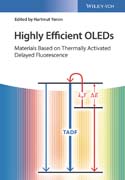
Highly Efficient OLEDs: Materials Based on Thermally Activated Delayed Fluorescence
Yersin, Hartmut
Edited by a pioneer in this fast developing field, the book compiles the latest results in OLED optimization. It discusses in detail the theoretical principles as well as various emitting materials, both organic and inorganic, along with display and lighting applications. INDICE: TADF material design –. Photophysical background and case studies focusing on Cu(I) and Ag(I) complexes. Highly efficient solution–processed organic light emitting diodes. TADF kinetics and data analysis in photoluminescence and electroluminescence. Efficiency enhancement of OLEDs exhibiting delayed fluorescence and non–isotropic emitter orientation. TADF materials based on donor–acceptor molecular systems. Highly emissive d10 metal complexes as TADF emitters. The role of vibronic coupling for intersystem crossing and reverse intersystem crossing rates in TADF molecules. Intersystem crossing processes in TADF emitters. Photophysics of TADF . Molecular design and synthesis of metal complexes as emitters for TADF–type OLEDs. Ionic Cu(I) TADF complexes and their use in OLEDs. Highly luminescent dinuclear copper complexes with short intra–molecular Cu–Cu distances. Novel TADF materials Thioxanthone derivatives and their application in OLEDs. Solution Processed TADF Materials and Devices . Status and next steps of TADF technology –. An industrial perspective. .
- ISBN: 978-3-527-33900-6
- Editorial: Wiley VCH
- Encuadernacion: Cartoné
- Páginas: 600
- Fecha Publicación: 08/08/2018
- Nº Volúmenes: 1
- Idioma: Inglés
